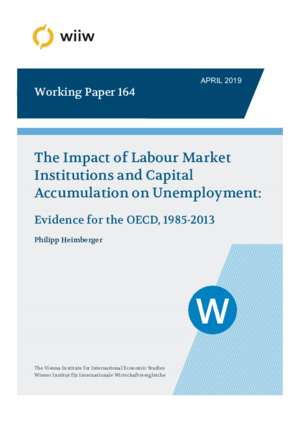The Impact of Labour Market Institutions and Capital Accumulation on Unemployment: Evidence for the OECD, 1985-2013
wiiw Working Paper No. 164, April 2019
34 pages including 6 Tables and 1 Figure
This paper provides econometric evidence on the impact of labour market regulations on (‘structural’) unemployment rates. Based on a data set for 23 OECD countries over the time period 1985‑2013, the panel regression results suggest that standard institutional labour market indicators – such as employment protection legislation, trade union density, tax wedge, minimum wages – largely underperform in explaining (medium-term) unemployment, while cyclical macroeconomic factors – in particular capital accumulation, but also the long-term real interest rate – are essential determinants. These results underscore that the existing macroeconometric evidence in favour of the view that labour market rigidities are at the heart of increased ‘structural’ unemployment in advanced economies is modest at best. Some labour market variables do have an impact on unemployment, but it is in general smaller than the impact of relevant macroeconomic variables. To understand the development of unemployment in OECD countries, researchers and policy-makers therefore should consider aggregate demand dynamics and focus on capital accumulation.
Keywords: unemployment, labour market institutions, NAIRU, capital accumulation
JEL classification: C54, E24, E62
Countries covered: Australia, Austria, Belgium, Canada, Czechia, Denmark, Finland, France, Germany, Hungary, Ireland, Italy, Japan, Luxembourg, Netherlands, New Zealand, Norway, Portugal, Spain, Sweden, Switzerland, United Kindom, USA
Research Areas: Macroeconomic Analysis and Policy, Labour, Migration and Income Distribution
